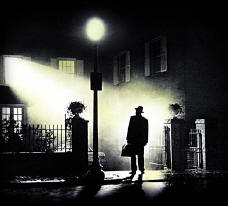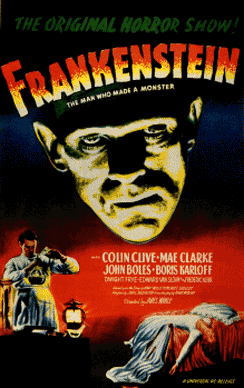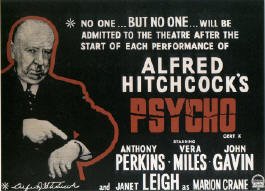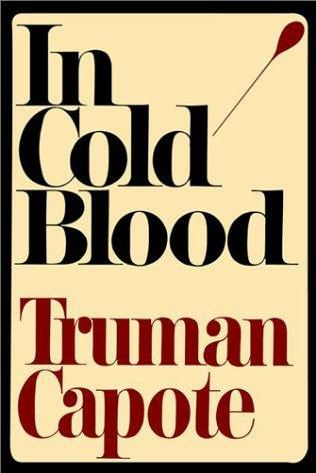(Other links to this class:
Bibliography;
Course notes;
Honors Seminars Home Page)
The Psychological
Appeal of Horror in Fiction and Film
Honors Seminar 3213
In the Washington, D.C. area in 1949, a reported case of possession occurred
involving an exorcism. At the time, William Peter Blatty was a student at
the Jesuit institution of Georgetown University when this highly unusual
event occurred. What fascinated Blatty as a student and served
 as the subject for his 1971 novel, The Exorcist, represented a
"life-affirming" event: if pure evil could be demonstrated, it proved an
absolute good as well. Carefully documented, Blatty's novel became an
instant bestseller and equally popular movie, grossing more than eight times
its initial investment.
as the subject for his 1971 novel, The Exorcist, represented a
"life-affirming" event: if pure evil could be demonstrated, it proved an
absolute good as well. Carefully documented, Blatty's novel became an
instant bestseller and equally popular movie, grossing more than eight times
its initial investment.
However, though Blatty wrote the screenplay as well as the book, the
emphases between the book and film remain clearly different. While the novel
posits a life-affirming, committed religiosity, the screenplay does not; the
latter plays to a different audience, and the temptation, clearly not the
book's intention, exists to see the demon Pazuzu's power as victorious over
the priests Merrin and Karras at the end of the film. Interestingly, another
famous work that considered the supernatural forces of good versus evil by
Ira Levine, Rosemary's Baby (1967)--also a best-selling novel and
popular movie--was condemned by the Catholic Church, while Blatty's more
intensely graphic book and film were not.
The Exorcist represents but one novel and film that we'll study in the fall
Honors seminar, The (Psychological) Appeal of Horror in Fiction and Film.
Why do people enjoy the thrill of being frightened, of contemplating
supernatural and thus uncontrollable situations, or take pleasure in reading
about horrendous events? Certainly, there lies a vast distinction between
the pathology and study of such impulses and how, much like action films,
they "entertain" us as escapist diversion: the horror genre remains
notorious for its great divide between quality and exploitation--should it
have higher pretensions or merely seek to entertain?
These represent but a few of the questions that this course will seek to
provide. Our course syllabus includes five movies, five novels (two of which
we'll both read and watch in film adaptation), and several psychological
studies on terror, fear, and the supernatural. In addition to studying the
style and impact of the novels, we'll investigate filming techniques,
directorial decisions, and casting. This course will undoubtedly raise more
questions than we can answer, because of the compendious nature of the
genre, even among more recent art forms such as film.
Consider for instance that most filmgoers today fail to appreciate the
impact of Boris Karloff's 1931 depiction of Frankenstein's monster, which
set the tone for what we most expect from our cinematic monsters: power
constitutes terror. Karloff endured more than five hours of make-up
preparation per day, from an enlarged head, to boots that weighed more than thirty pounds each (taking him to a height of seven feet,
six inches), and heavy leg braces that forced him to lurch as opposed to
walk. Besides the enormous weight loss of the ordeal, Karloff was
hospitalized at the conclusion of the film, shot in only six weeks. The
emphasis, however, between James Whale's direction of the movie and Mary
Shelley's classic novel remains even more remarkable than that between
Blatty's novel and screenplay. In reading and viewing these films, students
will investigate the work's "appeal to an audience" and how it changes over
time and with cultural tastes. Horror takes many forms. As these two
novels/films indicate, it can involve the supernatural or raise ethical and
moral questions, which remain no less frightening when we consider that
humanity can create a hideousness that easily rivals, if not exceeds, the
supernatural.
weighed more than thirty pounds each (taking him to a height of seven feet,
six inches), and heavy leg braces that forced him to lurch as opposed to
walk. Besides the enormous weight loss of the ordeal, Karloff was
hospitalized at the conclusion of the film, shot in only six weeks. The
emphasis, however, between James Whale's direction of the movie and Mary
Shelley's classic novel remains even more remarkable than that between
Blatty's novel and screenplay. In reading and viewing these films, students
will investigate the work's "appeal to an audience" and how it changes over
time and with cultural tastes. Horror takes many forms. As these two
novels/films indicate, it can involve the supernatural or raise ethical and
moral questions, which remain no less frightening when we consider that
humanity can create a hideousness that easily rivals, if not exceeds, the
supernatural.
One film and another movie will demonstrate these societal manifestations of
horror. Richard Brook's 1967 film of Truman Capote's "non-fictional novel,"
In Cold Blood, represents a faithful adaptation to the Capote
classic: in 1959, a family of four was found murdered in their home in the
small Mid-Western town of Holcomb, Kansas. People who had previously felt
safe and insular from the violence of American cities for the first time
locked their doors at night. The movie stands as a chilling adaptation of
the psychological profiles of two convicted felons who saw their victims as
representatives of a society that made them outcasts. Another novel that
exemplifies humanity's propensity for creating horror is Jerzy Kosinski's
The Painted Bird, a semi-autobiographical work not for the faint of
heart, which traces a young boy's odyssey through Eastern Europe during the
Second World War and his journey into the darkest recesses of civilization's
primal consciousness and inhumanity.

Two additional works will fill out our reading for the semester: selections
from Edgar Allan Poe's Tales of the Grotesque and Arabesque,
and Bram Stoker's Dracula, which has undergone numerous screen
adaptations, though reading the book should prove enlightening for those
only familiar with cinematic treatments. As for the other films, we will
watch a sophisticated, yet scary
movie that manages to avoid gore but offers more chills than most movies of
the last two decades: "The Haunting," directed by Robert Wise, and adapted
from the Shirley Jackson novel, The Haunting of Hill House. And
finally, we turn to that 1960 thriller, "Psycho," directed by Alfred
Hitchcock, who had never previously engaged in the genre and considered the
movie as more a "joke" than a work of terror--though no one else laughed.
 Few
know that Hitchcock based his Norman Bates character on a cannibalistic
killer from Wisconsin; but perhaps even more fascinating are the
behind-the-scenes travails and production problems with the film. Besides
offering a fascinating psychological study of terror and horror, Hitchcock's
film aptly demonstrates the intricacies of the film-maker's art and the
exceptional talents of an unparalleled director making the best of some
difficult decisions: the infamous "shower scene" remains a truly complex work
of directorial art.
Few
know that Hitchcock based his Norman Bates character on a cannibalistic
killer from Wisconsin; but perhaps even more fascinating are the
behind-the-scenes travails and production problems with the film. Besides
offering a fascinating psychological study of terror and horror, Hitchcock's
film aptly demonstrates the intricacies of the film-maker's art and the
exceptional talents of an unparalleled director making the best of some
difficult decisions: the infamous "shower scene" remains a truly complex work
of directorial art.
Students may find, however, they are more drawn to the psychological studies
of Freud, Jung, Erikson, and others with regard to our fascination for
horror. Insights into why we fear often prove more frightening than the
manipulation of senses when we read a novel or watch a film, because such
impulses stem from--perhaps lurk within--the human psyche. How strong is that appeal
within us? What fascinates us about the dangers inherent in the darker
recesses of humanity? And if those forces are supernatural, what protection
do we have if, in fact, they emanate from within as opposed to without?
stem from--perhaps lurk within--the human psyche. How strong is that appeal
within us? What fascinates us about the dangers inherent in the darker
recesses of humanity? And if those forces are supernatural, what protection
do we have if, in fact, they emanate from within as opposed to without?
Join us for a frightening and enlightening semester. Films will be shown on
five different Thursday evenings during the semester, beginning at 7:00 p.m.
until the movie's conclusion in order that we may watch them in their
entirety and as a group. During the seminar, we'll discuss specific
techniques and watch selected scenes as we analyze the films (popcorn
encouraged).
A final word: You should be aware of the content of A final word: You should
be aware of the content of the movies and novels for this seminar. Blatty's
The Exorcist and Jerzy Kosinski's The Painted Bird are
graphically violent, especially Kosinski's novel; as for the movies:
"Frankenstein" (No rating); "Psycho" (NR; but only because it was made
pre-code; violent); "The Haunting" (NR); "In Cold Blood" (NR); and "The
Exorcist" (Rated R; disturbing scenes, language).